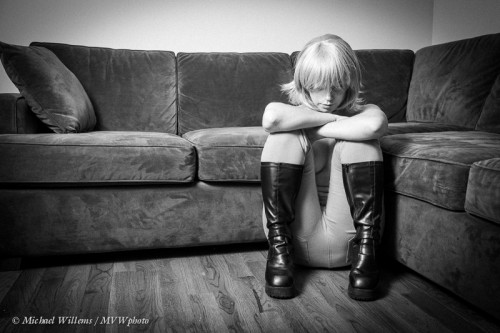Here’s a portrait I made a few days ago. A portrait I am very proud of; very proud indeed:
This portrait shows a young woman apparently reflecting. It raises questions – and as I have said many times, raising questions, in stead of spoon-feeding the answer, is what makes an image effective and interesting.
Here, the questions include: “On what is she reflecting? Why is she sitting there? Why is she looking at the floor? Is she sad? Is she waiting? For what?” Those questions are what matter, more than the answers, which you have to come up with. Her apparent loneliness is emphasized by the empty space around her, the bare couch, her guarded pose: existential loneliness, or just a break?
We do not know. But we can all identify. An image like this makes us think about our own lives, and the experiences we have had. The human condition is deliciously complex, sad, and wonderful; and sharing it with others is what art is about.
The composition also helps. I am not sure analyzing art is all that productive, but if you asked me I would say the following are effective technical elements in this image:
- Bare couch. Simplifying any image is key!
- Simple setting; negative space.
- The use of the rule of thirds.
- Simple black and white.
- A slight vignette.
- The subject’s face is not looking at us and is mainly hidden.
In a technical sense, this is easy. The use of off-camera flash is effective in creating just enough shadows. I used a Canon 1Dx, with an off-camera 430EX through an umbrella. Camera in manual mode, 1/200th sec, f/5.6, 400 ISO; with the flash in remote TTL mode. I used a prime 35mm f/1.4 lens.
You really can take images like this using a very simple setup, so think about subject, story and composition, not about the technical settings.

